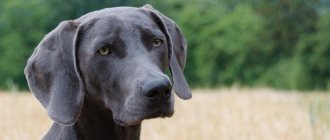Description of the St. Bernard breed
Popularity 119th place among 263 dog breeds
Lifespan:
9-11 years
Breed group:
Service
Height:
males: 70-90 cm, females: 65-80 cm
Country of origin:
Switzerland
Average price:
25-35 thousand rubles
Weight:
from 70 kg
Latest articles Cat health
Ataxia in cats: what it is, how it manifests itself and is treated 01/23/2022 169 0 0
Cat health
Leukemia, or viral leukemia in cats 01/23/2022 151 0 0
Breed traits
Breed traits (on a 5-point scale)
| Saint Bernard | |||
| Activity | in the house | 1.9 | |
| on the street | 3.1 | ||
| Obedience | training | 3.9 | |
| strangers | 4.2 | ||
| Domination | in family | 1.6 | |
| over dogs | 2.1 | ||
| Defending your territory | from people | 2.5 | |
| from dogs | 2.9 | ||
| Sociability | in family | 4.8 | |
| with strangers | 4.1 | ||
| with dogs | 3.3 | ||
| Concentration | in family | 1 | |
| in front of strangers | 1.5 | ||
| with dogs | 2.3 | ||
| Aggressiveness | in family | 1 | |
| to strangers | 1.4 | ||
| to the dogs | 1.7 | ||
| to cats | 1.5 | ||
| Family behavior | calmness | 4.1 | |
| demand for affection | 4.4 | ||
| excitability | 3 | ||
| playfulness | 3.5 | ||
| excessive barking | 1.7 | ||
| behavioral breakdowns | 1.9 | ||
| Tolerance for children | up to 4 years | 4.3 | |
| over 4 years old | 4.4 | ||
| Institutional use | watchman | 3.4 | |
| bodyguard | 1.7 | ||
This breed is often compared to the following dog breeds: Newfoundland, Caucasian Shepherd, German Shepherd, Labrador Retriever, Leonberger.
The photo shows what St. Bernards look like:
Advantages and disadvantages
- Pros:
- soft character - dogs are calm, friendly, patient;
- excellent security qualities;
- pickiness in food;
- tolerance towards other animals;
- possibility of keeping in open space;
- silence - the dog will not bark unless there is a reason for it;
- responds well to training.
- Minuses:
- large size, which makes it impossible to keep a dog in a small apartment;
- drooling, especially in summer;
- the need for thorough combing during shedding;
- low life expectancy;
- walking a St. Bernard requires a lot of physical strength;
- Large body weight provokes destruction of the hip joints (dysplasia).
Key facts
Saint Bernards look menacing, but are actually peaceful. Dogs have opposite traits: moderate playfulness, discipline, peacefulness, and courage. Representatives of the breed easily become attached to their owners, love children, and if you pay due attention to their training, they will be able to come to the rescue in any situation. Saint Bernards often become the heroes of funny photos and pictures. The characteristics of the St. Bernard breed include positive reviews that can be found on any dog breeders forum.
The country of origin of the good giants is considered to be Switzerland, namely the Swiss Alps. The territory is characterized by a capricious climate. Saint Bernards (the breed does not have an abbreviated name) lived for a long time in the monastery named after Saint Bernard and rescued travelers buried under the snow. As you can easily guess, the name of the breed came from the name of the monastery.
The description of the Saint Bernard breed says that these are large-sized animals, their minimum weight is 70 kg, the height at the withers (height) for females varies from 65 cm to 80 kg, for males - from 70 cm to 90 kg. The life expectancy of the St. Bernard is relatively long - both the male and the female live from nine to eleven years.
The minimum price for a purebred, healthy, vaccinated puppy according to the veterinary calendar is 25,000 rubles. The St. Bernard bought for this money has a mark, the RKF metric. The cost of the future exhibition winner ranges from 45,000 to 50,000 rubles. Also, puppies are sold on the Internet for “pennies” without required documents, but with a decrease in price, their purebredness is lost.
Saint Bernards are dogs with huge hearts
The Saint Bernard is a dog breed that deserves respect not for its impressive size, but for its kindness and wisdom. The Sen breed was bred quite a long time ago, by mating the Molossian Dane and the Pyrenees, which made it possible to obtain a dog capable of searching and rescuing people.
Saint Bernard puppy
The history of the breed begins in the Swiss Alps, in the monastery of St. Bernard. The monastery was located high in the mountains, and novices often got lost on the road, getting lost among the snow. Even then, the potential for saving human lives was noticed, thanks to which the breed soon spread throughout the world.
History of the origin of St. Bernard
This breed has a surprisingly long and complicated history - it is still not clear who the ancestors of the heroic dogs were. There are two theories regarding their origin.
It is believed that St. Bernards are descended from Tibetan Great Danes. They had a massive body and lived in the territory of Central and Asia Minor even before our era. Perhaps they came to the mainland thanks to Alexander the Great. Another version is that St. Bernards appeared as a result of mixing the Mastiff and Great Dane breeds.
The breed was named after the monk Saint Bernard, who founded a monastery in the Swiss Alps and set up a shelter for surprisingly intelligent and trainable dogs. The pass where he was located was distinguished by steep slopes and harsh climate; travelers often fell under avalanches, which is why the inhabitants of the monastery helped them instead of serving God.
In the 17th century, the animals, resistant to cold due to their dense undercoat and large body mass, began to help in the search for people. Saint Bernards were easily able to “predict” avalanches thanks to their excellent sense of smell. In addition, the dog was an excellent “quilted jacket” and helped the unlucky traveler stay warm until people arrived.
The nineteenth century was marked by the almost complete extinction of St. Bernards due to an unknown infection, and priests, in an attempt to endow the dogs with new qualities that increased survivability, began to cross them with representatives of the Newfoundland breed. The offspring of representatives of two different breeds looked more impressive, had long fluffy hair, but because of this they were completely unsuited to life in the snowy mountains. The monks released the long-haired dogs into the valleys, where they became watchmen, and left the short-haired dogs at the monastery.
The whole world learned about St. Bernards in 1887, when they were included in the breed register, where the “standard” of the breed is indicated, while they came to the USSR only after the Second World War. Before perestroika, several breeding individuals were used by dog handlers to create new breeds, and families were happy to have good-natured giants.
In the dangerous nineties, preference began to be given to daring and angry dogs, but the good-natured giants “returned” to Russia in 1996 thanks to the “National Club of St. Bernard Fans.” His goal was to preserve the breed, improve its qualities and gradually “reach” the masses.
Breed Features
Saint Bernards have always been helpers and rescuers. Distinctive features of the breed are courage and good nature. Their profession is saving human lives. The St. Bernard monastery at the foot of the Alps is considered to be the birthplace of St. Bernards, hence the name of the breed. It is there that you can find references to the first St. Bernard, who saved 41 people during his life.
All St. Bernard dogs are very demanding in terms of care. To maintain them, you need to have a lot of patience. It is especially important to start training puppies at a very early age.
Saint Bernards have a thick, two-layer coat, which allows them to withstand cold temperatures down to -60C and warm weather. Due to their size, almost all St. Bernards suffer from tympanitis (accumulation of gases in the stomach), they are also susceptible to entropy (eyelashes growing inward) and joint diseases. Unlike other dog breeds, such as Shar Peis or Basset Hounds, St. Bernards undergo entropy surgery in adulthood, when they reach their maximum size.
The difficulty in caring also lies in the fact that wherever the St. Bernard goes, fur and drool will definitely remain, so be prepared for this.
Saint Bernards are the best friends and caregivers. This breed is suitable for elderly or lonely people suffering from serious illnesses. They love everyone without exception, so you are unlikely to be able to raise a protector from a St. Bernard. Thus, the assessment of the Saint Bernard breed is as follows:
- Security qualities: 2/5
- Personality: 4/5
- Health: 1/5
- Care: 2/5
- Personality: 4/5
Appearance of St. Bernard
What does this big stuffed dog look like? In the photo, the St. Bernard appears to be huge, and indeed, representatives of the breed are considered giant dogs: a male can reach a height of 90 cm, a female - 80 cm; “boy” and “girl” must weigh at least 70 kg. There are two types of dogs: long-haired and short-haired. In any case, the animal's fur will be soft and shiny.
Head
The skull is massive, wide and rounded. The middle part of the head is crossed by the frontal groove. The muzzle is moderately wide. The occipital protuberance, brow ridges, cheekbones, and feet can be called well developed. If the dog squints, noticeable folds appear on the forehead. Characterized by a black square nose with large nostrils, dense dark lips, massive jaws, moderately deep-set eyes of any shade of brown, wide-spaced triangular ears of medium size.
Neck
Saint Bernards have a long, strong neck with a dewlap; Some dogs have too much dewlap, which is a disadvantage.
Torso
The body is strong and muscular. The chest is moderately deep, the stomach is tucked towards the ischial tuberosity, the back is wide, the croup is long, smoothly turning into the tail. The withers are well defined.
Forelegs
The front legs are parallel to each other, straight and set wide apart. The shoulders are quite muscular, longer than the sloping shoulder blades. The forearm and shoulder are the same length. Elbows fit tightly to the body.
Hind limbs
The hind legs are widely spaced and parallel to each other. The thighs are strong and well developed, the buttocks are wide. The knee joints cannot be considered turned either inward or outward. Characterized by a strong hock joint and straight metatarsus.
Tail
The St. Bernard's tail is wide at the base and heavy. When standing, the St. Bernard can lower it to the hock joint. The tail hangs down, slightly curving upward. If the dog is excited or alarmed, the tail rises a little higher.
Movement
Despite their dense build, the movements of St. Bernards are smooth. The limbs move “along the line”, the back remains motionless. At the exhibition, the dog needs to move at a trot, because thanks to this it is possible to detect a defect - a shift in the center of gravity.
Wool
There are two types of Saint Bernards - short-haired and long-haired. Short-haired individuals have a dense undercoat, their thighs and tail are covered with short hair. Long-haired animals have long, slightly wavy hair, and their undercoat is very thick. The fur on the paws, hips and tail is especially luxuriant.
Color
What colors characterize the colors of the St. Bernard? The traditional color is white with large spots and a “cloak” on the back and sides. The inclusions, starting with a red tint and ending with a mixture of red-brown and brindle, are considered normal. The presence of a black edging on the head and a black symmetrical mask are welcome. It is considered mandatory to have marks on the forehead, chest, paws, scruff and tip of the tail.
Size
The size of the St. Bernard is enormous (it belongs to the giant breeds), and this makes keeping the dog in an urban environment problematic. A one-month-old puppy already weighs 3-4 kg, and its height ranges from 25 to 28 cm. There is nothing to say about an adult animal - the minimum weight of a St. Bernard tends to be 70 kg (a male weighs from 80 to 105 kg, a female from 70 to 80 kg), and the height of St. Bernard is from 70 to 90 cm! Immobility has a detrimental effect on the dog’s health and emotional state. A small cottage may be the right place to keep it.
Purchasing methods
You should carefully weigh your decision before buying a St. Bernard, because in a couple of years the cute puppy will grow into a huge dog that will need to be kept somewhere and fed.
A breeder will never sell a dog unless he is sure that you are really interested in him and that you have everything to make your St. Bernard comfortable, namely: a spacious garden where he can stretch and a cool place where the dog can rest in the heat.
Gender and color are not of fundamental importance. All Saint Bernards have a standard coat of white with large red spots or one solid red spot along the entire back.
St. Bernard's character
If you have a St. Bernard, be prepared for the fact that this giant will be cramped in the apartment, which will make the dog less emotional. On the street, an adult animal will explore the world with interest. The character of the St. Bernard is phlegmatic by nature, and while puppies sparkle with emotions, adult dogs are distinguished by sedateness and importance.
Despite this, animals need to be surrounded by people who give them love, affection, understanding and tenderness; They are close to enthusiasm, they love to play outside in winter, having fun wallowing in the snow. The character of St. Bernards is characterized by the appearance of a rare melancholy, passive rather than active rest and, despite this, interest in everything that happens nearby.
Who is a St. Bernard dog suitable for? For a family person, because at home, alone with the owner, they behave more relaxed. Dogs of this breed can become a loyal friend to their owner, a caring nanny (children are not at all a burden to these giants), and first-class house watchmen. Other animals do not disturb the dog at all, nor do strangers. But at the same time, the giant can become a reliable guard if necessary.
Breed characteristics and character
Most people get scared when meeting an animal; even in a photo, the St. Bernard looks impressive. However, you should not be afraid of St. Bernards, because this breed of dog is distinguished by high moral qualities and intelligence.
Despite their enormous size, the hay takes up little space. Usually a small piece of territory is enough for them, but due to their love of love and some indifference, dogs are located right in the middle of the aisle or in the path of a person’s movement.
Adult St. Bernard on a walk in the forest
The character of the St. Bernard is melancholic; adults prefer a quiet pastime, unlike frisky puppies. During walks, the hay comes to life: most of all, dogs enjoy slow walks in nature, especially in previously unknown places.
The Saint Bernard breed is extremely sociable, gets along well with children, playing the role of a good nanny. Dogs are easy to train and educate, and conscientiously follow orders. There are many stories of St. Bernards saving lives.
This breed is a true friend of man, distinguished by devotion and love for the owner. Sens tolerate loneliness terribly and, without communication, often become bored or depressed, and a closed space or a chain for dogs is akin to betrayal - the animals become nervous and aggressive.
Saint Bernards are often used in search and rescue work; in France there is even a monument to the dog who saved 40 people
Education and training
Inexperienced dog owners think too late about training their pet and ask questions “how to educate”, “how to train” and “how to wean” only when the dog chews furniture, refuses to follow basic commands or growls when trying to put a muzzle on it.
Usually, raising and training St. Bernards begins no later than two months. By this point, the puppies have become smart enough to follow basic commands and endure short training sessions. At six months you need to accustom your dog to a muzzle. If you make training regular for a St. Bernard puppy, then the adult animal will happily perform exercise after exercise.
Saint Bernards are easily given all the basic commands: “Ugh!”, “Sit!”, “Next!” - except for fetching. If you offer the dog a treat, the command will be carried out more readily. In addition, you need to teach the puppy to tolerate “morning toilet” (rubbing the eyes, face, scratching) so that the adult dog reacts adequately to this.
A well-behaved, trained dog is sure to attract people's attention (in a positive way) no matter the season.
Health and disease of St. Bernard
Possible diseases
From birth, St. Bernards have excellent health, but over time, like people, they age, and diseases caused by heredity “come out” to the surface. They may have congenital problems with their ears (sometimes puppies are born deaf), paws, and eyes. Usually problems arise with the musculoskeletal system, the functioning of the digestive organs and endocrine system, and eye health. They chase animals throughout their lives.
The most common diseases in St. Bernards are:
- dysplasia (dislocation) of the elbow and hip joints;
- ligament ruptures;
- herniated discs;
- epileptic seizures;
- lymphoma;
- bone or blood cancer;
- eversion and inversion of the eyelids;
- cataract;
- metabolic disease;
- bloating;
- obesity;
- allergies (immune system reaction to food, viruses, insects, poor-quality vaccinations).
What should you do to get your pet to hold its tail like a gun? To prevent illnesses, it is advised to monitor the dog’s diet, do a “morning toilet” (comb the fur, wipe the eyes, face, nose, clean the ears); In addition, you need to monitor the condition of the St. Bernard's teeth and his sexual health.
Reproductive health
If the owner chooses not to breed the bitch, it is better to sterilize it (in this case the question will arise “what to feed a sterilized animal”). Often, breeders think about the offspring of their pet quite late, while the first mating of a female dog should occur no earlier than her second heat (the first comes at the age of 8-9 months) and no later than four years. If these conditions are not met, the animal’s health will be at risk: difficult pregnancy and childbirth, complications, the cost of treatment of which is high.
Typical diseases of the breed
Thanks to genetics, dogs are resistant to aggressive weather conditions and have strong immunity. Six hay protects against wind, moisture, and mechanical stress, but dogs do not tolerate heat well, especially long-haired breeds.
St. Bernards reach large sizes in growth
Saint Bernards have a healthy body and recommended vaccinations significantly reduce the risk of possible infectious diseases, but this is not the problem of this breed. Despite a strong skeletal frame and powerful muscles, heavy body weight has a detrimental effect on the health of the joints. Therefore, high-intensity or forceful exercise is contraindicated for dogs.
If you suspect a joint disease, you should immediately contact a veterinarian and protect your dog from stress, otherwise there is a risk of joint dysplasia or bone cancer. The most common problems are Wobbler's disease or herniated vertebral discs, which arise due to improper care and nutrition of the animal.
Treatment of these diseases is only possible through surgery, but dogs can easily tolerate such operations. If the dog has difficulty turning around its axis, you should immediately consult a doctor.
Saint Bernards practically do not freeze in winter
Features of feeding and diet
Saint Bernards are prone to obesity, so veterinarians often hear the question “what to feed the animal.” Starting from birth, you should carefully monitor your pet’s nutrition: choose good food or create a balanced diet that complies with the norms of proteins, fats and carbohydrates, and, if necessary, introduce vitamin complexes. Experts often advise purchasing a guide for feeding a puppy or a guide for feeding an adult St. Bernard so that inexperienced owners do not have any difficulties.
The choice of dry food is very important. For the first month, the puppy usually continues to eat the food introduced in the kennel. The age and weight of the dog determines what food to buy and how much to feed: puppies receive five or six meals a day, and adults receive two meals a day. How to feed a St. Bernard - food or regular food - depends on the owner.
Price
You can buy a dog in a specialized nursery or from dog breeders. When buying a puppy, you should pay attention to the health and genetics of the parents, the conditions and environmental friendliness of their place of residence, and review the medical history. The price of a St. Bernard varies depending on the region, its terrain and the demand for the breed. The average price for a puppy in a St. Bernard nursery reaches $1,500-2,000.
By purchasing a St. Bernard from a breeder, you can reduce the price a little, but you should carefully study the documents and pedigree of the puppy. The cost of this dog is a life full of impressions and joy for both you and your family.
St. Bernard puppy playing with a cat
Saint Bernard is a guard dog , a good friend, protector and assistant. Purchasing a puppy of this breed will become an event in your life, and the dog will become a member of the family. Discipline, intelligence and self-control are the hallmarks of the Sen's character, which, together with kindness and love, makes the dog ideal for a large family or an elderly couple. There are many stories about the exploits of these dogs, and if you decide to get a St. Bernard, you will get a loyal friend and a good protector.
Maintenance and care
Saint Bernards require a lot of living space because they are very large breeds of dogs. The most pleasant thing for a dog will be to stay in a cottage with a fenced area or in a spacious apartment. What should be the care and maintenance of a St. Bernard? Dogs of this breed need grooming - care for their appearance, which includes trimming their fur and nails, examining their ears, and cleaning their mouth, in particular their teeth. Owners of amazing fur require careful care, especially during the molting period, which occurs two or three times a year. The amount of hair loss depends on the type of breed - long-haired ones are more susceptible to this than short-haired ones. For St. Bernards, professional care is preferable, but do not forget about regular brushing of your pet at home.
Price and selection
For a St. Bernard puppy in Russia you will pay on average from 19 to 65 thousand rubles. This breed is not so common in the Russian Federation.
The main reason for the high prices lies in the rarity of this breed. In addition, St. Bernards are often born with genetic defects, which have already been mentioned earlier, and treatment, as well as planning pregnancy in dogs and their birth, require huge amounts of money from breeders. By purchasing dogs from professional single-breed kennels, you can be 100% sure that they are healthy and ready to go to a new family. Speaking about the St. Bernard, you shouldn’t even touch on the topic of buying a dog of this breed from someone else, since their puppies can easily be confused with Tibetan mastiff puppies, Alabai puppies, or even stumble upon a mixed breed.
Here is an example of the main characteristics that make up the cost of St. Bernard puppies:
- Purebred puppy and its parents
- No genetic diseases
- Health
- The character of behavior with people acquired from parents.
Tips for choosing a puppy
How to choose a puppy if there are not so many kennels breeding St. Bernards, and some of them have fabulous prices? Consulting a dog handler and visiting exhibitions can help in this difficult matter.
- Consultation
. Some breeders offer consultations for an additional fee. Experts explain what healthy St. Bernard puppies should look like and adequately assess their appearance (soft coat, absence of problems with the eyes and musculoskeletal system). Often the buyer is asked to make sure that the parents do not have serious illnesses. For example, if the bitch and the dog did not suffer from dysplasia, then the likelihood of this disease manifesting itself in the puppy is low. - Exhibition
. A good choice would be to visit an exhibition, where you can get to know the breeder and his pet directly, and see how well the animal meets the breed standards.
The cost also depends on the completeness of the package of documents. The puppy must be sold with a puppy certificate, which can later be exchanged for a pedigree, and a veterinary passport.
How, where, from whom?
There are not many nurseries engaged in breeding the St. Bernard breed, both in Russia and in Europe:
- Nursery in Moscow and Kolomna "Gorny Khrustal". Operating since 1993 All puppies from the beginning of the kennel's existence are presented on the official website.
- Nursery "House Stessy". It has been operating for 21 years, a single-breed nursery dealing exclusively with St. Bernards. Nizhny Novgorod.
- Kennel RKF-FCT “Nazarene” is a world-famous St. Bernard nursery. Chelyabinsk.
- Kennel "Club St. Bernard", located in France. Its inhabitants are only purebred and genetically healthy producers.
Source
How much does a Saint Bernard cost?
The price of a St. Bernard depends on the “purpose” of the animal and the urgency of the sale. Kennels usually sell three categories of puppies:
- Pet class
. The average price of a puppy not allowed for breeding due to the presence of serious defects in the exterior varies from 5,000 to 20,000 rubles. The seller is obliged to notify buyers of the severity of the defect. - Middle, or breed class
. A Saint Bernard with a minor defect will cost the buyer an average of 25,000 rubles. Such dogs participate in exhibitions and often take prizes. - Show class
. A dog of this level costs more than 30,000 rubles because it has a good gene pool; Breeders often leave such puppies in the kennel, because they will often take first places at shows.
A faithful friend, a reliable protector, a melancholic rescuer - all this is about the St. Bernard.
Happiness and comfort will always reign in the house where he lives. Do you like the article? 0
How to buy a Saint Bernard puppy
Buying a purebred puppy can be difficult, since the Saint Bernard is not a very common dog in our country. Moreover, in the 20th century the Moscow variety of the breed was bred. But there are many nurseries that can offer purebred St. Bernard. The price of such a puppy is 25-35 thousand rubles. For a show class dog you will have to pay more - from 50 thousand.
When choosing, you need to pay attention not only to the availability of all documents. It is important in what conditions the animals are kept, how the mother and puppies behave. The selected baby must be carefully examined. A healthy puppy has no watery eyes, clean ears, smooth and shiny fur, and a soft tummy. There should be no unpleasant odor from him, active and playful behavior.
The pictures show what the puppies look like:
More interesting photos of St. Bernards:
Before getting a St. Bernard dog, you should watch another video about it:
Video: Features of raising a St. Bernard dog
Video: The Saint Bernard is a smart companion, a great friend and a fearless guardian.
Video: St. Bernard - everything about the breed.
Saint Bernard is a large, but good-natured and calm dog. He is capable of becoming a good friend and protector. This pet is ideal for large families with children. But this giant requires a lot of space in the house, at least 3 hours of walks and communication. If you can’t pay attention to your dog, it’s better not to get this breed.











